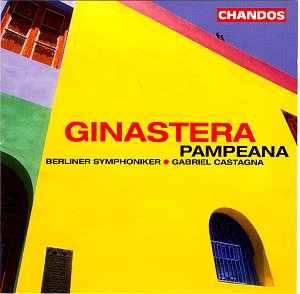Not so long ago, I
reviewed a recent all-Ginastera disc
(BRIDGE 9130) with a similar selection
of works. The main difference, however,
is that the BRIDGE release includes
a splendid recording of Ollantay
Op.17 whereas the one under
review offers a major, though still
rarely heard work, Glosses sobre
temes de Pau Casals Op.48.
I will not repeat my
earlier comments regarding the Obertura
para el "Fausto" criollo Op.9
and the popular Dances from "Estancia"
Op.8a. Suffice it to say that
these fairly early works clearly belong
to Ginastera’s early, nationalistic
period in which he consistently relied
on Latin-American rhythms and folk-music.
They are written in a fairly straightforward
and colourful manner.
Pampeana No.3
Op.24, "pastoral in three
movements", which also featured
in the BRIDGE record, was first performed
by Robert Whitney and the Louisville
Orchestra. It belongs to Ginastera’s
second stylistic period, in which folk-inflected
material is handled in a freer manner,
in much the same way as Bartók’s
so-called imaginary folklore. Bartók
exerted a lasting influence on Ginastera’s
mature music, e.g. in the string quartets,
the piano concertos and the cello concertos.
The original version
of Glosses sobre temes de Pau
Casals Op.46 was written on
a joint commission from the Festival
Casals of Puerto Rico in celebration
of the centenary of Casals’ birth and
from the Puerto Rico Committee for the
American Bicentennial. The commission
appealed to him because he was an admirer
of Casals and also because of the long
friendship that existed between Casals
and Aurora Natola-Ginastera who had
been one of his disciples. Moreover,
Casals had shown interest in Ginastera’s
work. Finally, both were of Catalan
origin. The original version, scored
for full string orchestra and string
quintet in lontano, was first
performed by the International Youth
Orchestra of the Centennial Festival
Casals. The composer admitted that while
composing the piece, he continuously
heard a symphony orchestra. So, when
Rostropovich requested a new work for
the National Symphony Orchestra, Ginastera
proposed the orchestral reworking of
Glosses. It was a considerable
task, though, which took him some considerable
effort. The orchestral version is, needless
to say, quite different in instrumental
colours from the original version, although
the latter is magnificent in its own
right. This partly explains why a new
opus number (Op.48) was allotted to
the piece. In many respects, the orchestral
version may be regarded as Ginastera’s
Concerto for Orchestra. In all but the
third and fifth movements, Ginastera
uses a number of themes by Casals. The
Introducció includes a
song of praise to the Virgin of Montserrat
from Casals’ Oracio a la verge
de Montserrat (1959) as a broad
chorale. The lyrical Romanç
that follows alludes to Tres estrofias
de amor composed in 1958. The
central section Sardanes, of
course, refers to the traditional Catalan
dance whiffs of which saturate the section.
The fourth movement Cant, based
on Casals’ popular Cant dell ocells
which he used to play as an encore,
is a beautifully atmospheric Nocturne
redolent of Bartók’s night music
movements. True to its title, the final
movement Conclusió delirant
is a brilliant, almost orgiastic evocation
of Catalonia, "in blood and gold"
(the colours of the Catalan flag). The
information concerning Casals’ themes
used in Glosses is drawn
from Rudy Elmis’ excellent notes for
the KOCH recording of both versions.
It is difficult to
understand why these fine, committed
and brightly recorded performances had
to linger for nearly ten years before
being released on disc. Choice between
the BRIDGE and the CHANDOS discs will
depend on which works you want to have.
Both versions of Glosses
were (and may still be) available on
KOCH 3-7149-2 in magnificent readings
by the London Symphony Orchestra conducted
by Gisèle Ben-Dor. (This fine
disc also includes a wonderful reading
of the somewhat better-known Variaciones
concertantes Op.23 by the Israel
Chamber Orchestra with the same conductor.)
Gabriel Castagna adopts a slightly more
leisurely tempo in Glosses
but is given a brighter, closer recorded
sound that some might prefer. This is
a fine release. I for one hope that
performing artists and recording companies
will now consider other Ginastera works
still conspicuously absent from the
catalogue, such as Estudios sinfonicos
Op.35, Iubilum Op.51,
Popol Vuh Op.44 (though
the latter was available on an RCA disc
some years ago) and the choral-orchestral
Psalm 150 Op.5 and Turbae
ad Passionem Gregorianam Op.43,
to mention but a few works that badly
deserve re-appraisal and consideration.
Hubert Culot
